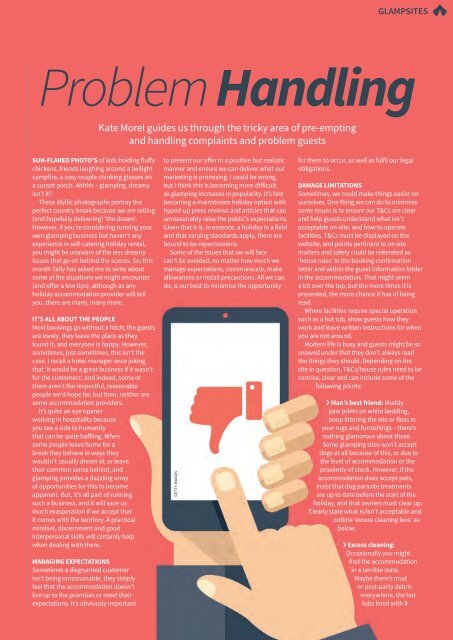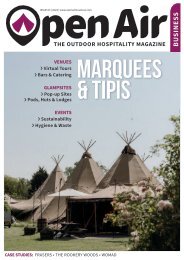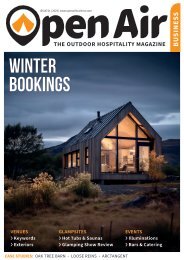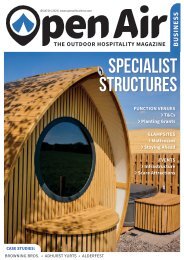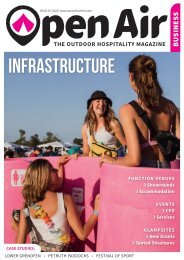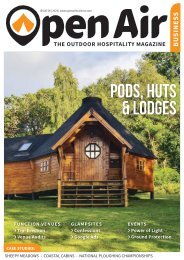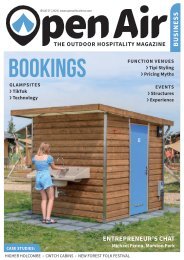Open Air Business August/September 2017
The UK's outdoor hospitality business magazine for function venues, glampsites, festivals and outdoor events
The UK's outdoor hospitality business magazine for function venues, glampsites, festivals and outdoor events
Create successful ePaper yourself
Turn your PDF publications into a flip-book with our unique Google optimized e-Paper software.
GLAMPSITES<br />
Problem Handling<br />
Kate Morel guides us through the tricky area of pre-empting<br />
and handling complaints and problem guests<br />
SUN-FLARED PHOTO’S of kids holding fluffy<br />
chickens, friends laughing around a twilight<br />
campfire, a cosy couple chinking glasses on<br />
a sunset porch. Ahhhh – glamping, dreamy<br />
isn’t it?<br />
These idyllic photographs portray the<br />
perfect country break because we are selling<br />
(and hopefully delivering) ‘the dream’.<br />
However, if you’re considering running your<br />
own glamping business but haven’t any<br />
experience in self-catering holiday rental,<br />
you might be unaware of the less dreamy<br />
issues that go on behind the scenes. So, this<br />
month Tally has asked me to write about<br />
some of the situations we might encounter<br />
(and offer a few tips), although as any<br />
holiday accommodation provider will tell<br />
you, there are many, many more.<br />
IT’S ALL ABOUT THE PEOPLE<br />
Most bookings go without a hitch; the guests<br />
are lovely, they leave the place as they<br />
found it, and everyone is happy. However,<br />
sometimes, just sometimes, this isn’t the<br />
case. I recall a hotel manager once joking<br />
that ‘it would be a great business if it wasn’t<br />
for the customers’, and indeed, some of<br />
them aren’t the respectful, reasonable<br />
people we’d hope for, but then, neither are<br />
some accommodation providers.<br />
It’s quite an eye opener<br />
working in hospitality because<br />
you see a side to humanity<br />
that can be quite baffling. When<br />
some people leave home for a<br />
break they behave in ways they<br />
wouldn’t usually dream of, or leave<br />
their common sense behind, and<br />
glamping provides a dazzling array<br />
of opportunities for this to become<br />
apparent. But, it’s all part of running<br />
such a business, and it will save us<br />
much exasperation if we accept that<br />
it comes with the territory. A practical<br />
mindset, discernment and good<br />
interpersonal skills will certainly help<br />
when dealing with them.<br />
MANAGING EXPECTATIONS<br />
Sometimes a disgruntled customer<br />
isn’t being unreasonable, they simply<br />
feel that the accommodation doesn’t<br />
live up to the promises or meet their<br />
expectations. It’s obviously important<br />
to present our offer in a positive but realistic<br />
manner and ensure we can deliver what our<br />
marketing is promising. I could be wrong,<br />
but I think this is becoming more difficult<br />
as glamping increases in popularity. It’s fast<br />
becoming a mainstream holiday option with<br />
hyped-up press reviews and articles that can<br />
unreasonably raise the public’s expectations.<br />
Given that it is, in essence, a holiday in a field<br />
and that varying standards apply, there are<br />
bound to be repercussions.<br />
Some of the issues that we will face<br />
can’t be avoided, no matter how much we<br />
manage expectations, communicate, make<br />
allowances or install precautions. All we can<br />
do, is our best to minimise the opportunity<br />
GETTY IMAGES<br />
for them to occur, as well as fulfil our legal<br />
obligations.<br />
DAMAGE LIMITATIONS<br />
Sometimes, we could make things easier on<br />
ourselves. One thing we can do to minimise<br />
some issues is to ensure our T&Cs are clear<br />
and help guests understand what isn’t<br />
acceptable on-site, and how to operate<br />
facilities. T&Cs must be displayed on the<br />
website, and points pertinent to on site<br />
matters and safety could be reiterated as<br />
‘house rules’ in the booking confirmation<br />
letter and within the guest information folder<br />
in the accommodation. That might seem<br />
a bit over the top, but the more times it is<br />
presented, the more chance it has of being<br />
read.<br />
Where facilities require special operation<br />
such as a hot tub, show guests how they<br />
work and leave written instructions for when<br />
you are not around.<br />
Modern life is busy and guests might be so<br />
snowed under that they don’t always read<br />
the things they should. Depending on the<br />
site in question, T&Cs/house rules need to be<br />
concise, clear and can include some of the<br />
following points:<br />
› Man’s best friend: Muddy<br />
paw prints on white bedding,<br />
poop littering the site or fleas in<br />
your rugs and furnishings – there’s<br />
nothing glamorous about those.<br />
Some glamping sites won’t accept<br />
dogs at all because of this, or due to<br />
the level of accommodation or the<br />
proximity of stock. However, if the<br />
accommodation does accept pets,<br />
insist that dog parasite treatments<br />
are up to date before the start of the<br />
holiday, and that owners must clear up.<br />
Clearly state what is/isn’t acceptable and<br />
outline ‘excess cleaning fees’ as<br />
below.<br />
› Excess cleaning:<br />
Occasionally you might<br />
find the accommodation<br />
in a terrible state.<br />
Maybe there’s mud<br />
or post-party debris<br />
everywhere, the hot<br />
tubs lined with ›


